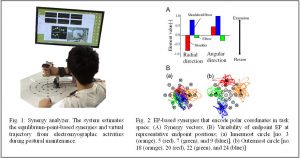Motor function analyzer, motor function analysis method and motor function analysis program
January 4, 2021
This system diagnoses and evaluates motor skill based on muscle synergy and equilibrium point trajectory
Key Word : motor function analysis, muscle synergy, myogenic potential signals, rehabilitation, sports
Background / Context / Abstract:
The present invention relates to the motor function analysis technology for the calculation of feature values related to motor control at the point of motion of the appropriate body part, for example, the tip of a limb.
With rapid aging of the population, there are high expectations for science and technology for supporting the promotion of health. For proper support, both the correct theory and scientific rationale that supports the theory are required. Previously, inventors have been searching for effective interventions and proposed the motor function analysis method that extracts the body coordination (muscle synergy) from the myogenic potential signals generated during voluntary motion and visualizes the motor strategy (operation of coded high-order variables realizing an equilibrium point trajectory) selected by the central nervous system for the realization of motion as a motor function analysis/evaluation tool that provides the scientific rationale. However, this method had a certain limitation in practical use for rehabilitation. Specifically, the motor function analysis requires the measurement of myogenic potential at the maximum voluntary contraction (MVC value). The maximum voluntary contraction is the motion performed by subjects under the maximum voluntary effort. Therefore, the output MVC value shows intra- and inter-individual variabilities due to various external and internal factors, and the results of the motion estimation may be affected by these variabilities. In addition, the maximum voluntary contraction can become a burden on elderly people and patients.
The present invention with consideration for the limitation described above provides a motor function analyzer, motor function analysis method and motor function analysis program that simplify the measurement of motion by eliminating MVC and improve the accuracy of analysis.
Technology Overview:
This invention enables the estimation of two motor function feature values of the muscle synergy and the equilibrium point trajectory from the motion measurement data (kinematics and myogenic potential) utilizing the physical constraint that occurs under a certain environment (i.e. “During posture retention under dead weight compensation, the position of the tip of the limb and the equilibrium point match.”). With very simple measurement and less burden on subjects, it is very useful. In addition, it is possible to include the display to present the results of the estimation superimposed on a video of motion performed by user or the drive part that provides physical supports such as a robot, electrical stimulation, etc. based on the results of estimation in the output device.
A series of inventions that diagnose and evaluate motor skill based on the motor function feature values (muscle synergy and equilibrium point trajectory) estimated with the motor command information from the central nervous system and promote motor learning through additional feedback is an innovative technology in the fields of rehabilitation and sports.
Benefits:
The present invention is superior to conventional technologies in usefulness regarding the operation of the technology. Particularly, the fact that the technology does not require the measurement of MVC value contributes to [1] simplification of the operation, [2] improvement in the accuracy of estimation and [3] the safety of measurement. This technology overcomes the issues associated with conventional technologies by utilizing the unchangeable physical relationship between the position of the tip of limb and the equilibrium point during posture retention that does not require a relatively large muscle force. The benefits described above will become prominent when this technology is actually used in the field of rehabilitation. In other words, it is expected that [1] while the workloads on therapists and technicians using the device are greatly reduced, [2] accuracies of diagnosis and treatment of motor function are improved and that [3] the burden on patients are also reduced.
Potential Applications / Potential Markets:
・Motor control evaluation device for the elucidation of motor generation mechanism and motor learning/motor recovery mechanism in healthy people and patients with cerebropathy
・Motor learning support device to establish an effective motor training method and motor intervention method to achieve a goal
・Interface evaluation device for design and evaluation of a machine, tool and environment that physically interacts with humans
State of Development / Opportunity / Seeking:
●Opportunity
・Available for exclusive and non-exclusive licensing
・Exclusive/non-exclusive evaluation for defined period (set up for options)
・Collaborative/supportive research
●Seeking
・Licensing
・Development partner
IP Status:
WO2018/047847 (National phase; JP,US)
Figures:
Contact:
![]()
